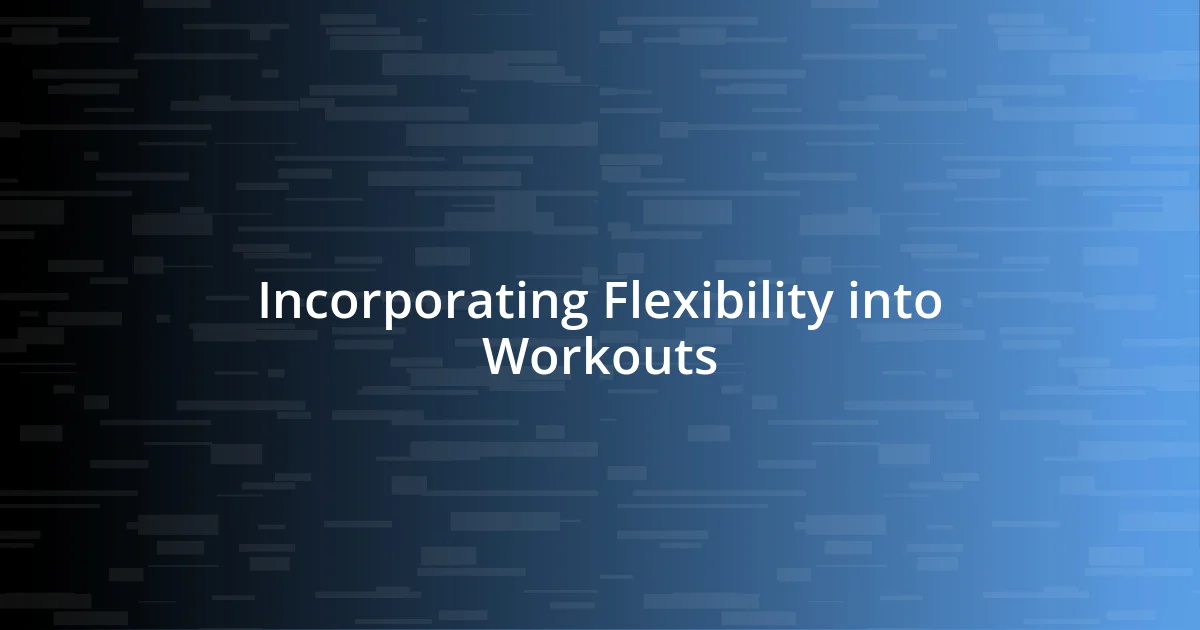Key takeaways:
- Incorporating flexibility practices, like daily stretching and yoga, enhances mental clarity, resilience, and overall well-being.
- Effective stretching techniques, including dynamic and static stretches, along with mindful breathing and visualization, contribute significantly to physical and emotional flexibility.
- Nutrition and hydration are crucial for optimal flexibility, with a focus on consuming fruits, vegetables, and healthy fats to support muscle elasticity and joint health.

Understanding Flexibility Benefits
Flexibility offers a myriad of benefits that go beyond just physical health. For me, incorporating stretching into my daily routine not only alleviates tension but also enhances my overall mood. Isn’t it fascinating how something as simple as stretching could shift our entire outlook on the day?
When I first embraced a more flexible lifestyle, I didn’t expect the mental clarity that followed. It’s like my thoughts became less tangled, making it easier to tackle challenges both at work and in my personal life. Have you ever felt that surge of fresh perspective after a good stretch or yoga session? It’s transformative.
Another benefit I’ve personally witnessed is improved resilience. During a particularly stressful period, I dedicated time to flexibility training, and I was amazed at how it grounded me. As I breathed through challenging poses, I felt my worries melt away—reminding me that resilience often stems from our ability to adapt, both physically and mentally. How does flexibility play a role in your life?

Daily Routines for Flexibility
Incorporating flexibility into my daily routine has become a non-negotiable for my well-being. I usually start my mornings with a brief stretching session, which sets a positive tone for the day. I can’t tell you how much of a difference it makes to loosen up those tight muscles first thing—I feel more energized and ready to tackle whatever comes my way.
Sometimes, I find that short “flexibility breaks” throughout the day work wonders. A quick 5-minute stretch session during work not only breaks the monotony but also helps me reset my concentration. Have you ever noticed how just standing up and extending your arms can turn around a sluggish afternoon? Trust me, these little breaks are game-changers.
On weekends, I love dedicating more time to flexibility training—especially through yoga. Last Saturday, I joined a local class that focused on deep stretching and found myself more centered and relaxed afterward. It’s these moments of sheer focus on my body and breath that remind me of the deeper connection we have to our physical selves. Making time for these practices helps me stay in touch with what my body needs and enhances my overall flexibility journey.
| Routine | Benefit |
|---|---|
| Morning Stretching | Sets a positive tone and increases energy |
| Flexibility Breaks | Improves focus and reduces midday fatigue |
| Weekend Yoga | Enhances relaxation and deepens body awareness |

Effective Stretching Techniques
When it comes to effective stretching techniques, I’ve found that incorporating dynamic stretches into my routine makes a significant difference, especially when I’m warming up before any physical activity. These stretches involve continuous movement and help increase blood flow and mobility. I remember feeling light and agile during my morning jog after dedicating just a few minutes to arm circles and leg swings. It’s incredible how energized I felt, as if my body was truly ready for the day.
Here are some effective stretching techniques I’ve come to love:
- Dynamic stretches (e.g., leg swings, arm circles) for warming up.
- Static stretches (held for 15-30 seconds) post-activity to improve flexibility and alleviate muscle tightness.
- Foam rolling to release muscle tension; it’s like getting a deep tissue massage at home.
- Yoga poses (like downward dog and warrior) that blend strength and flexibility, offering both physical and mental benefits.
I’ve also embraced the practice of incorporating breathing techniques during stretching. Focusing on my breath not only deepens my stretches but also calms my mind. There were moments when I felt overwhelmed, and simply taking a deep breath while reaching for my toes brought an unexpected sense of clarity. I can’t stress enough how this dual practice has improved both my flexibility and my emotional resilience.

Incorporating Flexibility into Workouts
Incorporating flexibility into my workouts has truly reshaped my fitness experience. When I started adding dynamic stretches as a warm-up, I noticed a remarkable boost in my performance. For instance, before a recent HIIT session, those leg swings and torso twists had me feeling invigorated, as if I was saying to my body, “Let’s get ready to move!”
Post-workout stretching is another key area that deserves attention. I often find myself in a blissful state after a good static stretch. I vividly remember one evening when I sank into a deep lunge and held it; the sense of relief that washed over me was indescribable. Have you ever felt that release in your muscles after a good stretch? It’s like your body is silently thanking you for the care and attention.
I can’t overstate the benefits of exploring different yoga poses during my workouts as well. One day, while practicing warrior II, I connected deeply with my breath. That moment brought not just physical flexibility but a meditative clarity I’d been seeking. The blend of body and mind in these practices makes me wonder: How often do we overlook the mental benefits that come from simply allowing our bodies to stretch and unwind? It’s a reminder that flexibility isn’t just about muscles; it’s about nurturing our whole selves.

Mindful Practices for Flexibility
Often, I find that incorporating mindful breathing into my flexibility practice has a profound impact. The other day, while stretching on my yoga mat, I noticed how each inhale heightened my awareness of my body’s limits. It struck me—what if we all took a moment to consciously breathe and listen to our bodies? This simple act transforms a routine stretch into a sacred moment of self-connection.
I also love integrating visualization techniques while I stretch. Recently, during a particularly challenging pigeon pose, I envisioned my tight muscles loosening with each breath. It was a game changer! This mental imagery not only enhances my physical experience but also allows me to cultivate patience and compassion toward myself. Have you ever played with the idea of visualizing your body as a flexible, flowing river? It’s incredible how this mindset can shift your experience from a chore into a rich practice.
Sometimes, I find joy in stretching outdoors, where nature surrounds me. I vividly recall a morning spent in a park, letting the sun warm my skin as I flowed through some gentle stretches. The fresh air invigorated me, making my body feel truly alive. It made me wonder: how often do we disconnect from our environment while practicing mindfulness? Engaging with nature adds a unique layer to my flexibility journey, reminding me that flexibility is about more than just the body; it’s about enjoying and cherishing the present moment.

Nutrition for Optimal Flexibility
Nutrition plays a pivotal role in promoting optimal flexibility, as the foods we consume provide the necessary fuel for our muscles and joints. I’ve found that incorporating a variety of fruits and vegetables into my daily meals enhances my body’s elasticity. Just the other day, I made a vibrant smoothie packed with spinach, bananas, and berries. Not only was it delicious, but it also left me feeling energized and ready to tackle my stretching routine with greater ease.
Hydration is another crucial element in maintaining flexibility. I vividly remember a day when I skipped my usual water intake, thinking it wouldn’t affect my workout. As I started my stretches, I felt unusually stiff and constrained. It hit me then—how often do we forget that our muscles thrive on proper hydration? Now, I make it a point to sip water consistently throughout the day, like a refreshing reminder that fluidity is essential for both body and mind.
Finally, I’ve discovered the benefits of healthy fats in my diet. Foods like avocados and nuts have become staples in my meals. I recall preparing a simple avocado toast topped with sesame seeds, which not only tasted heavenly but also gave my joints a nice boost. Isn’t it fascinating how the right nutrition can inspire a more flexible and adaptive body? When I fuel myself adequately, stretching feels more rewarding, reinforcing the notion that nurturing our bodies with the proper nutrients truly leads to physical freedom.

Tracking Progress in Flexibility
Tracking my progress in flexibility has become both a fascinating and enriching part of my routine. I keep a dedicated journal where I note down my stretching sessions, including the poses I practice and how I feel before and after. There’s something incredibly gratifying about seeing my improvements, even if they are small—like finally achieving that elusive deeper stretch in my hamstrings. Have you ever considered how writing down your experiences could reveal just how far you’ve come?
I also love using photos to visualize my progress. Occasionally, I snap a quick picture of my poses, comparing them over weeks or months. It amazes me to see the subtle changes in my posture and form. Sometimes, I almost don’t recognize the physical progress I’ve made until I review those images. Isn’t it refreshing to capture those moments that might otherwise slip by unnoticed?
Another effective tool I’ve found is using a simple tracking app that reminds me to stay consistent and set goals. I still remember the feeling of setting my first flexibility target—reaching a full split! Every time I check off a day where I worked towards that goal, I feel a sense of achievement wash over me. Do you track your flexibility goals, and if so, how does it motivate you? Knowing that I’m working toward something keeps me engaged and excited about the journey.














